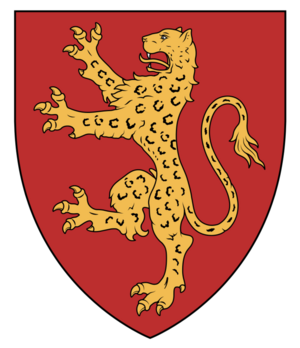House of De Pardo
Script error: The module returned a nil value. It is supposed to return an export table.
| Casa De Pardo | |
 | |
| Founded | 1105 |
|---|---|
| Founder | Elvio of Guiso |
| Type | Noble house |
Region served | Pelaxia |
| Affiliations | |
The House of De Pardo, alternatively spelled Pard in English (Pelaxian: Casa De Pardo; Cartadanian: Casa Do Pardo, Latin: Domus Pardus) and also known as the House of Pelaxia (Pelaxia: Casa de Pelaxia; Cartadanian: Casa da Pelaxia) is one of the most prominent dynasties in Sarpedonian history.
The house takes its name from Elvio De Pardo, a ranger to the Duke of Agrila and, who in one afternoon saved his lord from an attack by a Pelaxian leopard. After saving the lord of Agrila, he was awarded lands in the dukedom by him. Elvio would take the image of the leopard as a symbol of his family and surname, having fought with the same ferocity as the top predator in these valleys.
In 1485, his descendant Jerónimo de Pardo, now Duke of Agrila himself, would craft the Union of Termia between him, Reginaldo Castro-Brine of Alabalitoria and the Head Chancellor of the Montian Confederacy. The act arranged for Reignaldo's daughter Josefina to marry Jerónimo, which established the beginning of the Pelaxian Kingdom, still a vassal realm to Caphiria. The union strengthened both regions as self appointed protectors of Pelaxia, in their shared opposition to the newly formed Kingdom of Savria under King Didac l, self-appointed protector of the south.
The intention of the union was to create a common state under Albalitorian law, with the support of the ruling oligarchy in the Montian Confederacy. Castro-Brine would gain access to the trade passes through the Picos into the Dominate of Caphiria, while the Confederates would gain access to Albalitorian ports and sea routes. Thus, in the Jeronimian period, Pelaxia developed as a feudal state with a predominantly agricultural economy and an increasingly dominant mercantile nobility. The Cortes Regium act adopted by Jerónimo established the Corte General in 1516 and in 1605 transferred most of the legislative power in the state from the monarch to the Corte. This event marked the beginning of the period known as "Golden Liberty", when the state was ruled by the "free and equal" members of the Pelaxian aristocracy and nobility.
Origins
Myths
The Leopardslayer
In Sarpedon's valleys, where shadows dwell, A tale of courage, we're here to tell, Of Elvio De Pardo, a sheriff bold, Whose valorous deeds, in songs are told.
A leopard prowled, with eyes aflame, Striking fear, leaving hearts in shame, Under a lord's rule, of Castro Brine, Dark menace reigned, a chilling sign.
"Elvio!" they cried, "our guardian be, End this terror, set our spirits free!" Armed with resolve and a heart of stone, He embarked on a quest, the leopard to dethrone.
The Tale of The Leopardslayer is present in different versions as an epic poem of the Castro Brine age. It tells that in the lush valleys of Sarpedon, under the rule of a minor lord of the Castro Brine family, scribes wrote of a menace that began to haunt the inhabitants. A relentless leopard, with fur as golden as the sun and spots dark like the night, emerged from the shadows to wreak havoc upon the lands. Its ferocious raids and stealthy attacks left the village in a perpetual state of fear. As terror spread throughout the village, the lord sought the aid of his most trusted and resourceful alguacil, Elvio De Pardo. Known for his cunning and fearless disposition, Elvio was entrusted with the daunting task of putting an end to the leopard's reign of terror. He delved deep into the heart of the valleys, navigating dense jungles and treacherous landscapes in pursuit of the fearsome leopard.
Day after day, Elvio followed the leopard's tracks, encountering danger at every turn. The path was fraught with challenges, and the leopard's cunning nature made it a relentless adversary. Yet, driven by duty and determination, Elvio pressed forward, his resolve unshaken.
In a climactic showdown that resonated through the valley, Elvio faced the leopard head-on. A battle of strength, cunning, and sheer will ensued. With each move, Elvio anticipated the leopard's strikes, countering with unwavering determination. As the final clash resounded, it was Elvio who emerged victorious, having outsmarted the fearsome predator.
Word of Elvio's triumph spread swiftly throughout the village, and a wave of relief and celebration swept through the inhabitants. The minor lord, grateful for Elvio's heroism, bestowed upon him the lands that had once been plagued by the leopard's reign of terror. The image of the defeated leopard became a symbol of triumph over adversity and a testament to Elvio's indomitable spirit.
By this myth it is said that the House of De Pardo was born from this legacy of bravery, its members forever honored for their ancestor's valorous act of protecting the village. The defeated leopard, once a symbol of fear, transformed into an emblem of courage and resilience. The coat of arms of the House of De Pardo bore the figure of a leopard, a reminder of their ancestral hero and their dedication to defending the realm against any challenge.
From Barons to Kings
Family Tree
Notable Members
See Also